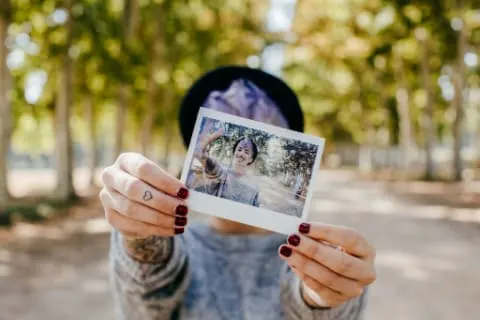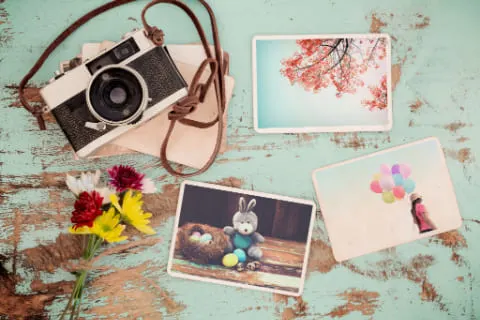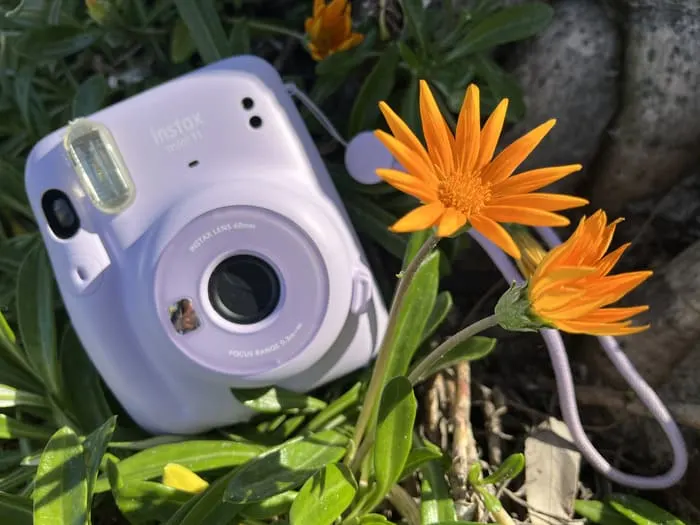Hello, fellow shutterbugs! I’m excited to dive into the world of ‘Instax Mini ideas’ with you, sharing my personal experiences and favorite ‘Instax Mini tips and tricks’ to enhance your instant photography.
As a seasoned photographer with a passion for the quirky and charming Instax Mini, I’ve gathered a wealth of knowledge tailored especially for beginners.
Whether you’re loading your first film pack or seeking creative ways to spice up your photo shoots, I’m here to guide you through every fun-filled step.
1. Ensure Proper Distance for Both Regular Shots and Selfies to Avoid Common Mistakes Like Out-of-Focus Images.
When using your Instax Mini, the correct distance between the camera and your subject is vital to getting those crisp, clear shots. For regular photos, maintain a distance of at least 60 cm (2 feet) from your subject. This will prevent any blurring and ensure everything is in sharp focus.
| Photo Type | Ideal Distance | Tips |
|---|---|---|
| Regular Shots | 60 cm (2 feet) | Don’t get closer. |
| Selfies | Arm’s length | Use the selfie mode and mirror |
For selfies, your Instax Mini’s selfie mode is designed to focus at arm’s length.
Remember not to be too close; a good rule of thumb is to extend your arm fully or use a selfie stick to achieve the best focus. Some Instax models have a built-in mirror next to the lens, so you can frame your selfies perfectly.
2. Focus on subjects that fill the frame sufficiently to avoid losing detail in smaller objects.
When you’re capturing memories with your Instax Mini, it’s essential to select subjects that can fill the frame adequately. This approach ensures your photos are clear and detailed. Here are some practical tips to help you with the framing:
- Get Closer: if safe and feasible, physically move closer to your subject. This will make the subject more prominent in the frame and highlight the details.
- Choose Larger Subjects: opt for subjects that naturally take up more space in your viewfinder.
Why Fill the Frame?
- Enhanced Detail: Smaller objects lose detail when they are too far away. By filling the frame, you preserve those intricate details.
- Visual Impact: A subject that fills the frame creates a powerful visual effect and makes for a more compelling photograph.
Best Practices:
- Position Carefully: Frame your subject to avoid unnecessary background distractions.
- Utilize the Viewfinder: Your Viewfinder is your best tool for ensuring your subject is appropriately framed before you take the picture.
3. Select subjects that stand out and resonate with your artistic vision.

When using your Instax Mini, it’s important to choose subjects that really pop and align with what you’re passionate about in photography. Here are a few tips to help you capture those special moments:
- Identify Your Style: Consider what themes or subjects you’re drawn to. Do you prefer urban landscapes or candid shots? Your style should guide your subject selection.
- Colors and Contrast: Look for subjects that offer a stark contrast or vivid colors against their background, making them jump out in your photos.
- Lighting Is Key: Soft lighting can highlight features, while sharp shadows can create an intriguing effect. Experiment with natural and artificial light to find your perfect shot.
- Emotions and Stories: Try capturing subjects that evoke emotion or tell a story, like a laughing child, a pensive elder, or a street performer in action.
- Simplicity Works: Sometimes, less is more. A simple yet striking composition can be more impactful than a busy scene.
4. Be Mindful of Finger Placement

When using your Instax Mini, your fingers have a sneaky way of slipping into places they shouldn’t be. It’s crucial to keep them away from two essential parts: the lens and the flash.
Here’s a quick checklist for ideal finger placement:
- Hold Steady: Grip the camera’s edges, curling your fingers away from the front.
- Thumb Position: Rest your thumbs on the back of the camera for balance, away from the lens and flash.
- Check Before Snapping: Do a quick visual sweep to ensure nothing’s in front of the lens or flash.
Remember, even a slight obstruction can cast shadows or create unwanted dark spots on your precious memories. Keep your digits in check, and you’ll be on your way to capturing Instax Mini masterpieces!
5. Utilize natural light to enhance the warmth and quality of your photos.

When capturing memories with your Instax Mini, embracing the power of natural light can significantly improve the warmth and atmosphere of your pictures. Here’s how you can make the best out of sunlight:
Timing is Key
- Golden Hour: Snap your photos during golden hour, just after sunrise or before sunset, to give your pictures a soft, golden glow.
- Midday Sun: Avoid the harsh midday sun, which creates solid shadows and overexposed spots.
Position Matters
- Backlight: Position the sun behind your subject for a dreamy backlight effect, but be careful not to point directly into the sun.
- Shade: On sunny days, look for open shade to avoid harsh contrasts. A diffused light can be your ally.
Reflectors Help
- DIY Reflector: Use simple white cardboard to bounce light onto your subject’s face, brightening up those joyous smiles.
6. Experiment with multiple angles to capture the same subject from varied and interesting perspectives.
Capturing a subject from different angles with your Instax Mini can transform a simple shot into an intriguing collection. Here are some angle variations to try:
- High Angle: Stand above your subject and point your camera downward. You’ll get a flattering perspective that can make the scene seem more intimate.
- Eye Level: Shooting at eye level creates a direct and personal feeling in your photos. It’s straightforward and usually the angle we naturally see from.
- Low Angle: Go down to the level of your subject or even below. This makes your subject appear larger than life and can add a sense of power or grandeur to your image.
- Bird’s-eye View: Find a high vantage point to snap a photo directly overhead. You’ll capture an unconventional layout that can lead to striking compositions.
- Oblique Angle: Tilt your camera for a dynamic and edgy effect. It adds movement and can create a playful mood.
7. Identify subjects that work well with instant photography, such as portraits, street scenes, and impromptu moments.

Choosing the right subject is critical to capturing those magical snapshots when using your Instax Mini. Here’s a quick guide to spotting ideal subjects:
- Portraits: Your Instax is perfect for capturing a person’s essence. Look for expressive eyes and genuine smiles. Spontaneous close-ups often result in the most memorable portraits. Embrace each individual’s imperfections and uniqueness.
- Street Scenes: The bustling energy of city streets makes for dynamic photos. Balance your frame between people and architecture. Let your instincts guide you to captivating interactions.
- Impromptu Moments: Unexpected scenes can be the most intriguing. Snap a picture of a street performer, a fleeting moment of laughter, or a sudden gesture. The magic of instant photography is in its ability to seize the unplanned.
8. Enhance Your Subject by Choosing Backgrounds That Offer High Contrast.
Using a high-contrast background in your photography can separate your subject from its surroundings, drawing more attention. Remember, with your Instax Mini, the focus is on capturing memories effortlessly. Experiment with different backdrops to see what best accentuates your subjects. Happy snapping!
9. Utilize your camera’s double exposure feature to create artistic and surreal overlays in your photographs.
Your Instax Mini isn’t just a point-and-click camera—it’s a tool for creative expression! The double exposure feature is like having an artist’s brush at your fingertips, letting you merge two images into one for a truly magical effect.
To get started with double exposure:
- Prepare Your Subjects: Choose two complementary subjects that will blend well together.
- First Exposure: Take your first photo as usual.
- Second Exposure: Without advancing the film, capture your second image. This will be superimposed onto the first.
Here are a few tips to keep in mind:
- Contrasting Images: Pair a silhouette with a textured backdrop for a striking look.
- Use Natural Light: It can help to illuminate and give depth to your overlays.
- Experiment: Don’t be afraid to try different combinations.
10. Use your camera in social settings to break the ice, capturing fun and spontaneous moments that engage new acquaintances.

The Instax Mini is more than just a camera; it’s a social butterfly’s best friend. Don’t hesitate to whip out your Instax Mini to capture the moment’s energy in a social setting. Here are a few tips to make the most of it:
- Introduce Your Camera: A quick “Hey, I’m taking some fun Polaroids. Would you like to be in one?” is a great icebreaker.
- Capture Candid Moments: While posed shots are great, candid photos often capture the genuine fun of social gatherings. Keep your camera handy for those unscripted laughs and smiles.
- Share the Love: Hand out the instant photos as keepsakes. Watch as the instant photo develops – it’s a great conversation starter.
11. Use the camera’s brightness adjustment settings to reduce light intake when shooting in bright settings to prevent overexposed photos.

Bright scenes can sometimes lead to overexposed shots when you’re out capturing memories with your Instax Mini. But don’t worry; you can easily manage this with the camera’s built-in brightness adjustment.
- Hi-Key: Ideal for softer impressions.
- Normal: A safe bet for standard lighting.
- Darken: Reduces light for a clearer image in bright environments.
Tip: Remember that film develops best in moderate temperatures, so extreme cold or heat can also affect the exposure.
12. Experiment with capturing motion, like moving vehicles or people walking, to add a dynamic element to your photos.
Capturing motion with your Instax Mini adds an exciting twist to your snapshots, turning the ordinary into something extraordinary. Here’s how you can freeze the hustle and bustle of life onto your instant film:
- Preparation is Key: Before you start, ensure plenty of natural light. This helps to prevent your photos from coming out underexposed.
- Shutter Speed Savvy: Your Instax Mini has a fixed shutter speed (usually around 1/60s), which is suitable for capturing movement if you use it creatively.
- Stay Steady: Brace yourself against a solid object or use a tripod to keep the camera still. This ensures that the background remains sharp against the moving subject.
Panning Technique:
- Follow your subject with your camera as it moves.
- Press the shutter button while smoothly panning along with the motion.
- Reveal a photograph where your subject is in focus, and the background shows motion streaks.
Motion Blur Magic:
- Hold your camera still and let the subject move freely in the scene.
- The slower your subject, the more subtle the blur, so experiment with different speeds!
Pro Tip: Try taking pictures of cars zipping by in a busy street, a cyclist on a picturesque trail, or people striding across a lively plaza.
13. Attach Color Filters Over Your Flash to Create Mood Lighting and Color Effects in Your Instant Photos.
Transforming the ambiance of your instant photos is as easy as adding a splash of color. Color filters, or gels, are transparent pieces of colored plastic that you can place over your Instax Mini’s flash to bathe your images in different hues, instantly altering the mood and feel.
Quick Tips:
- Use darker color filters for a more pronounced impact.
- Subtle tones can be achieved with lighter filters for a hint of color.
- Mixed lighting shots? Apply a filter to only one of the lights if using external flash units.
14. Keep your camera lens clean and free of fingerprints or dust to ensure clarity and sharpness in your photos.

Keeping the camera lens clean is crucial to maintain the quality of your Instax Mini photos. Here’s a concise guide to help you:
- Use a Blower: Use a blower to gently remove any loose dust from the lens surface without making contact.
- Microfiber Cloth: Gently wipe the lens with a dry microfiber cloth to remove fingerprints and smudges.
- Lens Cleaning Solution: For stubborn dirt, lightly dampen the cloth with a lens cleaning solution, then clean the lens in a circular motion.
- Avoid Excessive Moisture: Never apply the cleaning solution directly to the lens, and avoid using too much liquid that could seep into the camera.
15. Review each photo after it develops; learn what works and what doesn’t to continuously improve your photography skills.
After your Instax Mini has worked its magic, take a moment to review each photo. This isn’t just about appreciating your work—it’s a step towards becoming a better photographer. Look closely at each developed picture and ask yourself a few key questions:
- Composition: Is your subject well-placed? Do the elements in the frame lead your eye through the picture?
- Focus: Is the main subject in sharp focus?
- Exposure: Is the photo too bright or too dark?
- Emotion: Does the photo convey the feeling or story you intended?